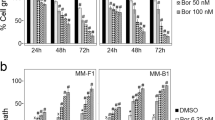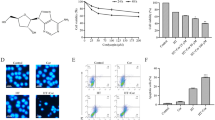Abstract
Hyperthermia is a unique treatment option for cancers. Multiple myeloma (MM) remains incurable and innovative therapeutic options are needed. We investigated the efficacy of hyperthermia and carfilzomib in combination against MM cells. Although MM cell lines exhibited different susceptibilities to pulsatile carfilzomib treatment, mild hyperthermia at 43℃ induced MM cell death in all cell lines in a time-dependent manner. Hyperthermia and carfilzomib cooperatively induced MM cell death even under suboptimal conditions. The pro-survival mediators PIM2 and NRF2 accumulated in MM cells due to inhibition of their proteasomal degradation by carfilzomib; however, hyperthermia acutely suppressed translation in parallel with phosphorylation of eIF2α to reduce these proteins in MM cells. Recovery of β5 subunit enzymatic activity from its immediate inhibition by carfilzomib was observed at 24 h in carfilzomib-insusceptible KMS-11, OPM-2, and RPMI8226 cells, but not in carfilzomib-sensitive MM.1S cells. However, heat treatment suppressed the recovery of β5 subunit activity in these carfilzomib-insusceptible cells. Therefore, hyperthermia re-sensitized MM cells to carfilzomib. Our results support the treatment of MM with hyperthermia in combination with carfilzomib. Further research is warranted on hyperthermia for drug-resistant extramedullary plasmacytoma.





Similar content being viewed by others

Data availability
All data generated or analyzed during this study are included in this published article.
References
Hayashi K, Nakamura M, Sakamoto W, Yogo T, Miki H, Ozaki S, et al. Superparamagnetic nanoparticle clusters for cancer theranostics combining magnetic resonance imaging and hyperthermia treatment. Theranostics. 2013;3:366–76.
Hayashi K, Nakamura M, Miki H, Ozaki S, Abe M, Matsumoto T, et al. Magnetically responsive smart nanoparticles for cancer treatment with a combination of magnetic hyperthermia and remote-control drug release. Theranostics. 2014;4:834–44.
Hayashi K, Nakamura M, Miki H, Ozaki S, Abe M, Matsumoto T, et al. Gold nanoparticle cluster-plasmon-enhanced fluorescent silica core-shell nanoparticles for X-ray computed tomography-fluorescence dual-mode imaging of tumors. Chem Commun (Camb). 2013;49:5334–6.
Miki H, Nakamura S, Oda A, Tenshin H, Teramachi J, Hiasa M, et al. Effective impairment of myeloma cells and their progenitors by hyperthermia. Oncotarget. 2018;9:10307–16.
Asano J, Nakano A, Oda A, Amou H, Hiasa M, Takeuchi K, et al. The serine/threonine kinase Pim-2 is a novel anti-apoptotic mediator in myeloma cells. Leukemia. 2011;25:1182–8.
Hiasa M, Teramachi J, Oda A, Amachi R, Harada T, Nakamura S, et al. Pim-2 kinase is an important target of treatment for tumor progression and bone loss in myeloma. Leukemia. 2015;29:207–17.
Fujii S, Nakamura S, Oda A, Miki H, Tenshin H, Teramachi J, et al. Unique anti-myeloma activity by thiazolidine-2,4-dione compounds with Pim inhibiting activity. Br J Haematol. 2018;180:246–58.
Adam K, Lambert M, Lestang E, Champenois G, Dusanter-Fourt I, Tamburini J et al. Control of Pim2 kinase stability and expression in transformed human haematopoietic cells. Biosci Rep. 2015;35(6):e00274
Stewart D, Killeen E, Naquin R, Alam S, Alam J. Degradation of transcription factor Nrf2 via the ubiquitin-proteasome pathway and stabilization by cadmium. J Biol Chem. 2003;278:2396–402.
Abe M, Hiura K, Wilde J, Shioyasono A, Moriyama K, Hashimoto T, et al. Osteoclasts enhance myeloma cell growth and survival via cell-cell contact: a vicious cycle between bone destruction and myeloma expansion. Blood. 2004;104:2484–91.
Bonet-Costa V, Sun PY, Davies KJA. Measuring redox effects on the activities of intracellular proteases such as the 20S Proteasome and the Immuno-Proteasome with fluorogenic peptides. Free Radic Biol Med. 2019;143:16–24.
Kuhn DJ, Chen Q, Voorhees PM, Strader JS, Shenk KD, Sun CM, et al. Potent activity of carfilzomib, a novel, irreversible inhibitor of the ubiquitin-proteasome pathway, against preclinical models of multiple myeloma. Blood. 2007;110:3281–90.
de Haro C, Mendez R, Santoyo J. The eIF-2alpha kinases and the control of protein synthesis. FASEB J. 1996;10:1378–87.
Mitsuishi Y, Motohashi H, Yamamoto M. The Keap1-Nrf2 system in cancers: stress response and anabolic metabolism. Front Oncol. 2012;2:200.
Steffen J, Seeger M, Koch A, Kruger E. Proteasomal degradation is transcriptionally controlled by TCF11 via an ERAD-dependent feedback loop. Mol Cell. 2010;40:147–58.
Radhakrishnan SK, Lee CS, Young P, Beskow A, Chan JY, Deshaies RJ. Transcription factor Nrf1 mediates the proteasome recovery pathway after proteasome inhibition in mammalian cells. Mol Cell. 2010;38:17–28.
Yoneda T, Hiasa M, Nagata Y, Okui T, White F. Contribution of acidic extracellular microenvironment of cancer-colonized bone to bone pain. Biochim Biophys Acta. 2015;1848:2677–84.
Ferrer-Montiel A, Fernandez-Carvajal A, Planells-Cases R, Fernandez-Ballester G, Gonzalez-Ros JM, Messeguer A, et al. Advances in modulating thermosensory TRP channels. Expert Opin Ther Pat. 2012;22:999–1017.
Gees M, Owsianik G, Nilius B, Voets T. TRP channels Compr Physiol. 2012;2:563–608.
Alptekin M, Eroglu S, Tutar E, Sencan S, Geyik MA, Ulasli M, et al. Gene expressions of TRP channels in glioblastoma multiforme and relation with survival. Tumour Biol. 2015;36:9209–13.
de Jong PR, Takahashi N, Harris AR, Lee J, Bertin S, Jeffries J, et al. Ion channel TRPV1-dependent activation of PTP1B suppresses EGFR-associated intestinal tumorigenesis. J Clin Invest. 2014;124:3793–806.
Wu TT, Peters AA, Tan PT, Roberts-Thomson SJ, Monteith GR. Consequences of activating the calcium-permeable ion channel TRPV1 in breast cancer cells with regulated TRPV1 expression. Cell Calcium. 2014;56:59–67.
Beider K, Rosenberg E, Dimenshtein-Voevoda V, Sirovsky Y, Vladimirsky J, Magen H, et al. Blocking of Transient Receptor Potential Vanilloid 1 (TRPV1) promotes terminal mitophagy in multiple myeloma, disturbing calcium homeostasis and targeting ubiquitin pathway and bortezomib-induced unfolded protein response. J Hematol Oncol. 2020;13:158.
Lipchick BC, Utley A, Han Z, Moparthy S, Yun DH, Bianchi-Smiraglia A, et al. The fatty acid elongase ELOVL6 regulates bortezomib resistance in multiple myeloma. Blood Adv. 2021;5:1933–46.
Niewerth D, Jansen G, Assaraf YG, Zweegman S, Kaspers GJ, Cloos J. Molecular basis of resistance to proteasome inhibitors in hematological malignancies. Drug Resist Updat. 2015;18:18–35.
Wallington-Beddoe CT, Sobieraj-Teague M, Kuss BJ, Pitson SM. Resistance to proteasome inhibitors and other targeted therapies in myeloma. Br J Haematol. 2018;182:11–28.
Sha Z, Goldberg AL. Multiple myeloma cells are exceptionally sensitive to heat shock, which overwhelms their proteostasis network and induces apoptosis. Proc Natl Acad Sci U S A. 2020;117:21588–97.
Roufayel R, Johnston DS, Mosser DD. The elimination of miR-23a in heat-stressed cells promotes NOXA-induced cell death and is prevented by HSP70. Cell Death Dis. 2014;5: e1546.
Ri M. Endoplasmic-reticulum stress pathway-associated mechanisms of action of proteasome inhibitors in multiple myeloma. Int J Hematol. 2016;104:273–80.
Ri M, Iida S, Nakashima T, Miyazaki H, Mori F, Ito A, et al. Bortezomib-resistant myeloma cell lines: a role for mutated PSMB5 in preventing the accumulation of unfolded proteins and fatal ER stress. Leukemia. 2010;24:1506–12.
Qin JZ, Ziffra J, Stennett L, Bodner B, Bonish BK, Chaturvedi V, et al. Proteasome inhibitors trigger NOXA-mediated apoptosis in melanoma and myeloma cells. Cancer Res. 2005;65:6282–93.
Ma Q. Role of nrf2 in oxidative stress and toxicity. Annu Rev Pharmacol Toxicol. 2013;53:401–26.
Aneiros E, Cao L, Papakosta M, Stevens EB, Phillips S, Grimm C. The biophysical and molecular basis of TRPV1 proton gating. EMBO J. 2011;30:994–1002.
Amachi R, Hiasa M, Teramachi J, Harada T, Oda A, Nakamura S, et al. A vicious cycle between acid sensing and survival signaling in myeloma cells: acid-induced epigenetic alteration. Oncotarget. 2016;7:70447–61.
Acknowledgements
The funders had no role in the study design, data collection and analysis, decision to publish, or preparation of the manuscript.
Author information
Authors and Affiliations
Contributions
T.M., H.M., and M.A. designed the study and wrote the manuscript. All authors were involved in the analyses and interpretation of data. All authors approved the submission of the manuscript.
Corresponding authors
Ethics declarations
Conflicts of interest
M.A. received research funding from Chugai Pharmaceutical, Sanofi K.K., Pfizer Seiyaku K.K., Kyowa Hakko Kirin, Janssen Pharma K.K., Takeda Pharmaceutical, Teijin Pharma, and Ono Pharmaceutical, and honoraria from Daiichi Sankyo Company. The other authors declare no competing financial interests.
Additional information
Publisher's Note
Springer Nature remains neutral with regard to jurisdictional claims in published maps and institutional affiliations.
Supplementary Information
Below is the link to the electronic supplementary material.
About this article
Cite this article
Maruhashi, T., Miki, H., Sogabe, K. et al. Acute suppression of translation by hyperthermia enhances anti-myeloma activity of carfilzomib. Int J Hematol 119, 291–302 (2024). https://doi.org/10.1007/s12185-023-03706-8
Received:
Revised:
Accepted:
Published:
Issue Date:
DOI: https://doi.org/10.1007/s12185-023-03706-8



